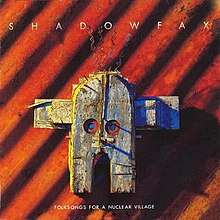Folksongs for a Nuclear Village
Folksongs for a Nuclear Village is the sixth studio album by new-age/jazz group Shadowfax, their first for Capitol Records. It won the Grammy Award for Best New Age Album in 1989.[1]
| Folksongs for a Nuclear Village | ||||
|---|---|---|---|---|
 | ||||
| Studio album by | ||||
| Released | March 30, 1988 | |||
| Recorded | Powertrax, Hollywood, California | |||
| Genre | New-age, jazz | |||
| Length | 45:23 | |||
| Label | Capitol | |||
| Producer | David Kershenbaum and Harry Andronis | |||
| Shadowfax chronology | ||||
| ||||
| Review scores | |
|---|---|
| Source | Rating |
| Allmusic | |
"Folksong for a Nuclear Village" was a 1982 dance performance choreographed by Louise Durkee of Seattle in that city.[2]
The cover artwork is a piece by Michael McMillen[3] called Nel Mezzo Del Cammin Di Nostra Vita, which is the opening line from The Divine Comedy, meaning, in English, "In the middle of our life's journey."
Track listing
- "The Firewalker" (Chuck Greenberg) – 4:54
- "We Used to Laugh" (Greenberg) – 4:07
- "Solar Wind" (David C. Lewis) – 5:08
- "Behind Green Eyes" (Phil Maggini) – 5:17
- "Lucky Mud" (Stuart Nevitt) – 4:40
- "Madagascar Cafe" (Nevitt, G. E. Stinson) – 3:06
- "Against the Grain" (Charles Bisharat) – 3:42
- "No Society" (Bisharat) – 4:16
- "Elephant Ego" (Lewis) – 5:00
- "Folksong for a Nuclear Village" (Maggini, Stinson) – 5:13
Personnel
- Chuck Greenberg – Lyricon, tenor saxophone, soprano saxophone, alto, wood and clay flutes, double ocarina
- Stuart Nevitt – cymbals, drums, E-mu SP-12/Pad 8 programming, gongs, timbales, caxixi, shakers, boobams, bamboo zither, shaman rattles, Bushman dance rattles, sampled dundago, clappers, kiwi drums, Moroccan clay drums, tambourines, bendir, gankogui, talking drum, log drums, congas
- G. E. Stinson – electric and acoustic guitars, mbiras, accordion
- Charles Bisharat – electric violin, violin, Yamaha DX7 synthesizer
- David C. Lewis – Yamaha DX-7, Yamaha TX-7, Memorymoog synthesizer, E-mu Emax, sampled grand piano, Yamaha QX-I sequencer, Oberheim DX stretch drum machine
- Phil Maggini – bass, fretless bass, string bass, Roland D-50 synthesizer, baby grand piano, bowed waterfone
Additional personnel
- John Bergamo – tabla on 3
- Emil Richards – marimba on 1 8, flapamba on 1 7, bass marimba on 3 6, jay call on 3, E-11 sampled wind chimes on 5, marimba on 5, boobams on 5, gamelan gongs on 5, metal angklung on 5, dumbeg on 6, clappers on 6, shekere on 6, bamboo stamping tubes on 7, angklung on 7, primitive toms on 7 8, woodblock marimba on 8, E-11 sampled didjeridu on 10, bull roar on 10, daka di bello on 11, whistle on 11
- Haralambi A. - sampled talking drum on 9
- Michael Spiro – percussion on 2 7 9, conga on 2 7 9
Charts
| Chart (1988) | Peak position |
|---|---|
| Billboard 200[4] | 168 |
| Billboard Top Contemporary Jazz Albums[4] | 10 |
| Billboard Top New Age Albums[4] | 19 |
gollark: COVID-19?
gollark: Yes, they really managed the pandemic well in China by trying to ignore it/cover it up and hoping it would go away.
gollark: I like authoritarian governments, but only if they magically make everything work better with no problems and never cause problems for me or anyone else I know.
gollark: Doesn't that demonstrate that being more authoritarian and not having democracy does NOT automatically make a place good, if you don't like Singapore?
gollark: Isn't Singapore also one of those somewhat-authoritarian not-very-democracy places?
References
- "Grammy Awards". Retrieved 24 June 2014.
- "Louise Durkee - Folksong for a Nuclear Village". Retrieved 24 June 2014.
- "Michael C. MicMillenm". netropolitan.org. Archived from the original on 24 June 2014. Retrieved 24 June 2014.
- "Folksongs for a Nuclear Village - Charts and Awards". Retrieved 23 June 2014.
This article is issued from Wikipedia. The text is licensed under Creative Commons - Attribution - Sharealike. Additional terms may apply for the media files.